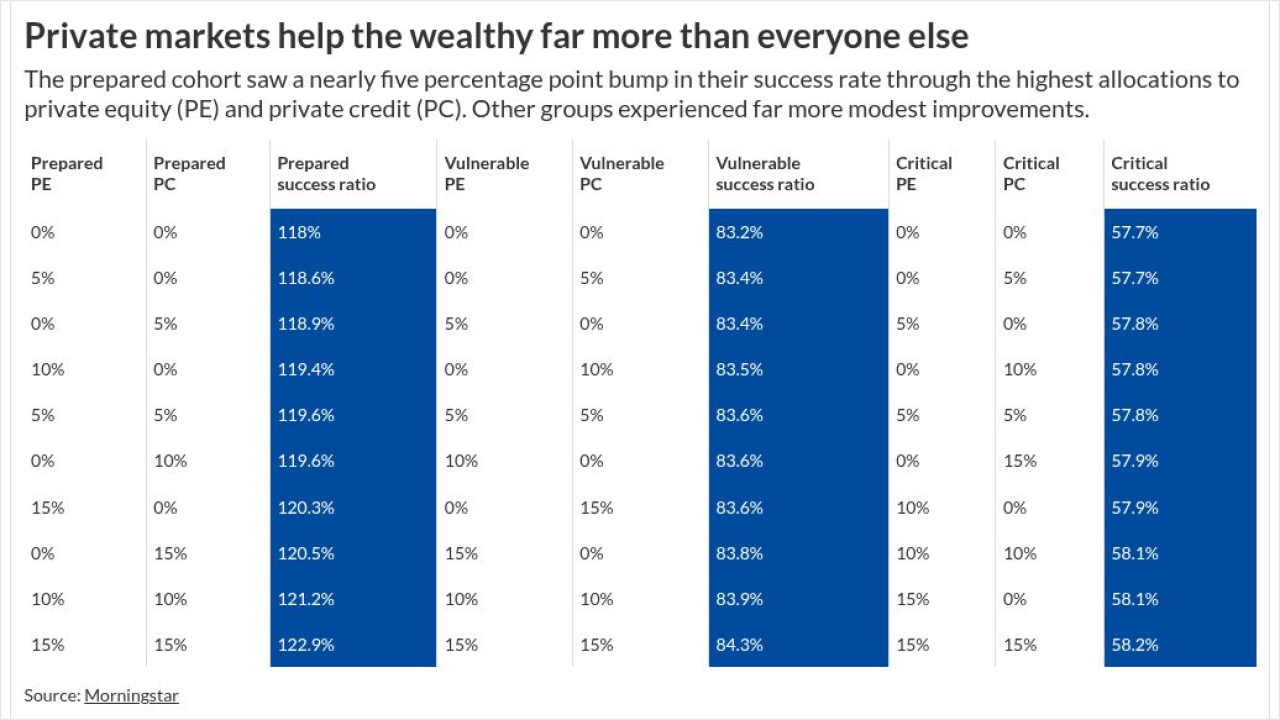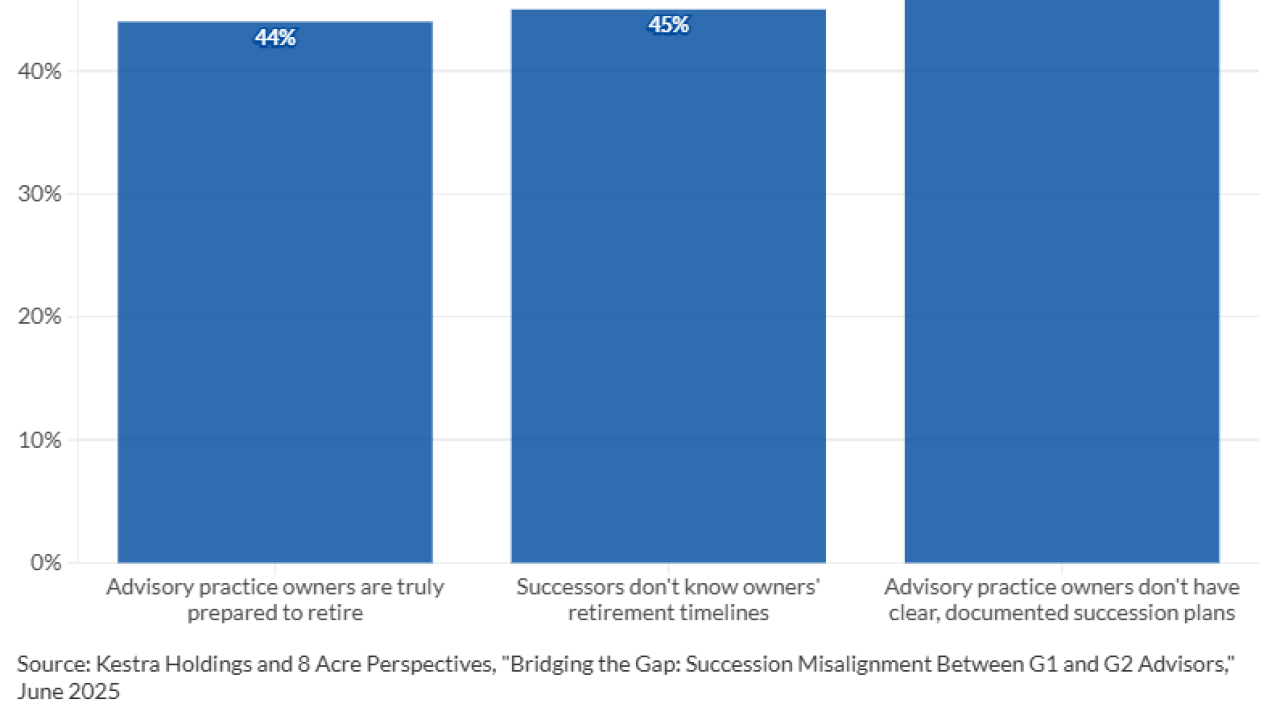Place this one firmly in the "good problems to have" category: Company executives are often so busy running their businesses that they have trouble managing their own frequently complex compensation plans.
Such time-strapped head honchos now figure as a key part in Morgan Stanley's strategy to take a bigger slice of the wealth management pie in the workplace. Executives' distinct needs align particularly well with the services offered by two units within the Wall Street mainstay.
One one side, there's Morgan Stanley at Work, which helps companies do everything from setting up 401(k) retirement and equity-compensation plans to providing financial planning to employees. On the other, there's Morgan Stanley Private Wealth Management, which works exclusively with affluent clients and families.
The special conundrums that executive compensation plans can pose play into both of the divisions' strengths, said Liz Dennis, the head of the private wealth unit. Take, for instance, the
Dennis said Morgan Stanley has a team dedicated to helping companies' top officers navigate the intricacies of the 10b5-1 and similar regulatory requirements. Beyond that, executives have many of the same wealth management needs as other affluent clients.
"Some of those solutions include managing equity compensation, financial planning, deferred compensation, estate planning, investment management, and many of our clients are focused on philanthropy and giving back as well," Dennis said.
READ MORE:
Dennis' colleague, Scott Whatley, the head of Morgan Stanley at Work, said the services also include help with technical matters like mandatory form filings and stock-vesting requirements.
Despite all the complexity, the end goal is simple.
"Ultimately, it's about allowing the executive to focus on the job that they've been hired to do," Whatley said. "We want to remove as much of this complexity and friction [as possible] and allow them to focus on the things that they've been hired to do."
Morgan Stanley's interest in workplace wealth goes all the way to the top of the firm. Speaking in New York in June at the firm's U.S. Financials, Payments & Commercial Real Estate Conference,
The workplace division reported $452 billion in AUM
Morgan Stanley at Work now provides services to more than 2,300 public companies, including about 40% of the firms listed on the S&P 500, and more than 1,000 private businesses. It helps manage equity-compensation plans, both through the
Dennis, who came to Morgan Stanley in 2001 to work on its debt syndicate desk, and Whatley, brought on board as part of the firm's
This interview has been lightly edited for clarity and brevity.
Financial Planning: Do most of your relationships with company executives come through Morgan Stanley at Work or the private wealth unit? What about other business-to-business relationships with investment banking?
Liz Dennis: What we've been able to do in partnership with Scott and his team is really to be agnostic as to: Is the relationship originating from a B2B workplace channel, or is it originating in private wealth? In some cases, we have relationships on both sides.
But our ultimate goal as we collaborate across these two channels is to deliver the whole ecosystem of Morgan Stanley. And the strategic acquisitions that we've made around the equity-administration business, for Shareworks, as well as E-Trade, have given us a really unique tool to do so, as well as with collaborating with our investment bankers.
And while we might be focused, from a client segmentation perspective, on the executives for our private wealth business, we have a whole suite of other products that executives clearly care about for their broad employee base.
FP: Looking beyond executives, where do regular employees fit in Morgan Stanley's wealth management plans?
Scott Whatley: There's roughly a trillion dollars in assets in the workplace for us today. And, as Ted [Pick] indicated in his comments, it's roughly 50/50 in terms of vested and unvested. And we think there's roughly $5 trillion held away.
So it's about engaging the employees no matter where they are along their financial journey. And that's whether you're new to the workforce and dealing with things like student debt and refinance opportunities, or you just need a self-directed experience.
We also have an opportunity to meet the needs of junior executives getting equity for the first time, [when they] have a little more complex needs. And it's making sure that we're engaging those individuals in those conversations and establishing relationships early in the process with them, either with an FA or a virtual FA.
We continue to win mandates and retain our existing client base, where we have 50% market share. And we continue to establish trust, not only with the B2B relationship, but how we're engaging their employees as well. It's thinking about how we start to not only retain the assets from the equity program themselves, which we're doing at a really high rate today, but also bringing in assets held away.
We think with the kind of market penetration we have today, we have roughly 50% of the S&P 500, the likelihood that at some point in your career you will have a relationship with Morgan Stanley is pretty high.
LD: To double down on that a little bit, the collaboration between the investment bank, the workplace and the advisor-led channel has never been stronger. In some cases, we already have the relationships and investment banking and the workplace, and we're just drilling down on other services that we can provide them, in addition to equity administration. Those can be around community-directed share programs, around cash management, executive financial services, all of that. But in some cases, we only have one of the relationships — either in the workplace or in the investment bank. Now we're really bringing the two together to say: Here's how we've added value for other corporate clients.
SW: The only two things I would add to that, from a quantitative perspective, is why we're having so much success in building a moat around our existing client base. Our client retention within workplace has been 99% for multiple years now. That's been publicly reported.
And in terms of how we're acquiring new business, we're winning more than two-thirds of the mandates within workplaces that we go after. It's because of that integrated firm strategy.
FP: Why do you see workplaces as such a great opportunity for mining AUM?
LD: We believe it is one of the largest growth areas because it allows us to be much more scaled in our approach versus previous growth strategies. Those were effective. But they were much more targeted to individual clients.
If you're going individual by individual, that takes more time. But if we are able to access employees and executives through the workplace channel, it makes our efforts much more scaled and, also, more holistic in the way that we are thinking about what's most relevant to those clients. We know more about them because we already have a relationship with them through B2B relationships.
SW: Also, that's where for most people wealth is created. It's through the workplace. And what we've seen since, really 2019, in the Solium [Shareworks] acquisition, the number of participants that Morgan Stanley has relationships with has ballooned from 2.5 million to over 18 million now. More than 12 million of those are specifically within the workplace channels. So it certainly is the flywheel to growth.
FP: We've talked in the past about
SW: [Silicon Valley] is where it all originated. But in terms of it being more of a broad market, I think one of the things we continue to see evolve is that this is now expanding across the country. When you think about the fight for talent, the retention and acquisition of top talent, equity is becoming a greater driver for that talent.
It's always been that way in Silicon Valley, with its startup nature. But we're starting to see that evolve more geographically, I'd say, in terms of granting to a broader set of individuals.






